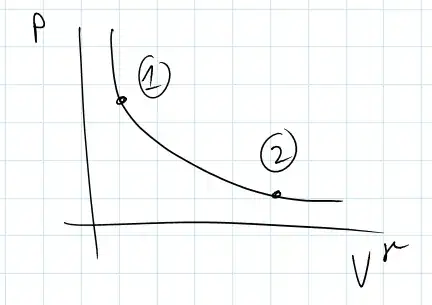I'm going through the exercises in a Thermodynamics book, just to revise and build my intuition. Right now, I'm working on:
Show that for a quasistatic adiabatic process in a perfect gas, with constant specific heats:
$$PV^\gamma = \left[\text{constant}\right]$$
with $\gamma = \frac{C_P}{C_V}$
where $P$ is pressure, $V$ is volume, and $C_V$ is the constant-volume heat capacity.
I'm not looking for the answer, just for a hint (I'm stuck and want to find the solution myself).
So those are my thoughts:
- perfect gas means: $PV = RT$, ($R$ is the universal gas constant)
- adiabatic means: $\mathrm{d}Q = 0$, ($Q$ for heat)
- since there is no heat exchange, the process is reversible
- reversible means: $\mathrm{d}W = -P \, \mathrm{d}V$, ($W$ is for work)
- heat capacity is defined as $C_\text{V} = \left( \frac{\mathrm{d}Q}{\mathrm{d}T} \right)_V$, respectively $C_\text{P} = \left( \frac{\mathrm{d}Q}{\mathrm{d}T} \right)_\text{P}$
If I draw a $PV$ diagram for this situation, it looks like this:
$\hspace{175px}$ .
.
Now I want to show that $PV^\gamma=\left[\text{const}\right]$ by going from $\text{State 1}$ to $\text{State 2}$ in the $PV$ diagram.
I've started like this: $$ W ~=~ -\int_{V_1}^{V_2}P \, \mathrm{d}V ~=~ -\int_{V_1}^{V_2} \frac{RT}{V} \mathrm{d}V ~=~ RT \ln{\left(\frac{V_2}{V_2}\right)} $$
This leads me into the wrong direction though. I thought about using $R = C_P - C_V$ here, but it doesn't seem to work. Any suggestions?
Please just give me a hint, not the solution.